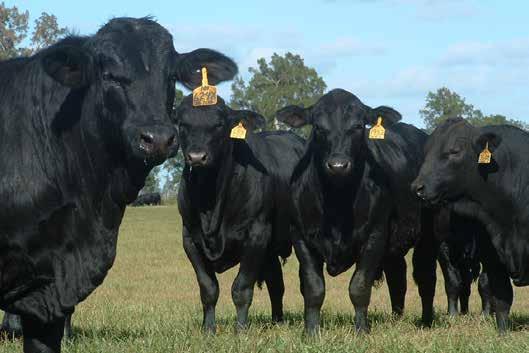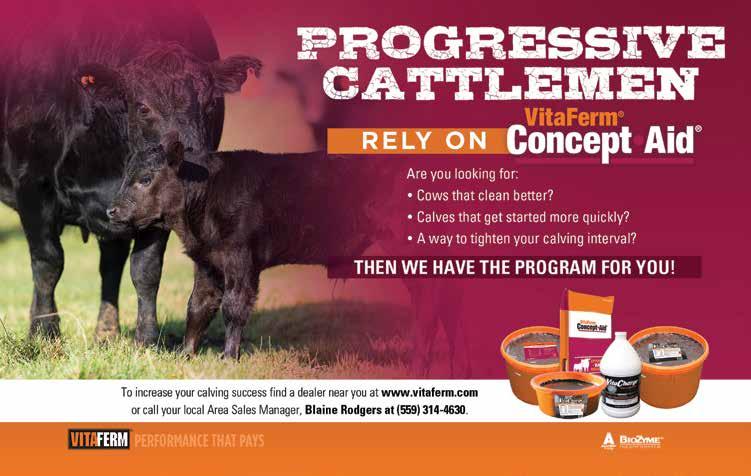
6 minute read
Brangus brings longevity, fertility
Fertility and Longevity:
THE ONE-TWO PROFIT PUNCH
by International Brangus Breeders Executive Vice President Darrell Wilkes, Ph.D.
No matter how you do the math, fertility and longevity of cows add up to the difference between profit and loss in most cow-calf operations. Thousands of opinion articles and scientific research papers have been written on this subject. I have not read a single one that makes a compelling case elevating any other trait over these. It’s fun to brag about percent Choice or percent Prime on the grading rail at a packing plant, or the average daily gain in a feedlot, but I have not seen a solid economic argument convincing me that anything trumps fertility and longevity when it comes to rancher profitability. There is no debate that these are critical measures of profit performance for every producer.
We often hear that fertility is not highly heritable, which can easily be misunderstood to mean that genetics don’t matter. When it comes to fertility, nothing could be further from the truth. Having genetics that aren’t well-suited to the environment in which they are producing is one of the surest ways to lose money in the cattle business. Conversely, having cowherd genetics that truly fit their environment is the pathway to profitability. In the opinion of many observers, including this author, many cowherds across the country have been moving away from the genetic profiles that are suited to their environment. This is particularly true in the southern tier of states and extending as far north into the fescue belt as southern Ohio and Virginia. It has happened in the southwestern desert as well. The data makes it clear that many (far too many) producers have trended toward straight bred British breeds even in these harsh environments.
It’s the “bandwagon” effect. It may seem like the thing to do, but it is most assuredly reducing the bottom line for many producers. Reducing the level of heterosis in a commercial cowherd is almost guaranteed to reduce fertility and longevity. Brangus genetics, which offer both heat tolerance and an elevated level of heterosis compared to British and Continental cross cattle, can and do deliver improved fertility and longevity in these harsh environments. The old joke, spoken by many commercial cattlemen with Brangus cows, is that “I have cows that are old enough to vote.” It isn’t always a joke. There are a lot of teenage Brangus cows in production in these tough environments. If you will do the math and figure the true depreciation cost of a cow that has 6-7 calves versus a cow that produces 9-10 calves, it is easy to see that longevity has a major economic impact on the bottom line. If a bred heifer has a cost of around $1,700 (raised or purchased), and a cull cow has a salvage value of about $700, the $1,000 spread is the true depreciation. Dividing this cost over six calves produces a cow depreciation cost of about $167 per calf. Dividing it by nine calves lowers the per-calf depreciation cost to $111. The $56 difference represents the difference in profit and loss for many commercial producers.
I have found myself in numerous debates with my university professor friends who say that a 10-12-year-old cow has “old” genetics which are dragging down the average genetic value of the herd and, thus, the resulting calf crop. In theory, a producer should turn the herd over faster to capitalize on the freshest genetics and improve the rate of genetic improvement. I discount that argument for a commercialproducer, and fully support that argument for a seedstock producer. My advice to commercial producers is to save the money you’d throw away by culling a fertile and productive old cow and invest it to upgrade your bull purchases. That old cow is not as much of a drag on your genetic average as you think and, besides, if she is more than a decade old and still weaning a healthy calf every year, I want as many of her daughters in my herd as I can get. Don’t you?
In pursuit of a perceived advantage in carcass value, I submit that a lot of cattle producers have sacrificed fertility
and longevity – they are giving up many more dollars than they believe they are gaining in feeder calf price.
The last sentence contains two words that are italicized – perceived and believe. There is a perception that the kind of cattle that thrive in harsh/hot environments sacrifice carcass quality traits. This may have been true two decades ago, but it is not true today if one uses Brangus genetics – and we have the data to prove it. However, it is acknowledged that this perception is deeply rooted and will require continued diligence and widespread education to change this engrained mindset. The International Brangus Breeders Association (IBBA) is committed to proving to the feeding and packing sectors and the buyers who work for them, that a well-bred Brangus feeder calf will match the feedlot performance and carcass value of anything else they can buy.
Too many people believe that price and profit are synonymous. They absolutely are not the same thing. In exchange for a $0.05 “premium” that might be paid for a straight bred British feeder steer over a steer with a little “ear,” I fear there are a lot of producers giving up many times that amount of money trying to run cows that simply do not fit their environment. You’ve seen them. Rather than grazing and producing milk to raise a heavy calf, they hang out in the pond or under the tree. In the southwestern desert, they hang out by the water tank where no grass exists. The cow isn’t grazing and her calf isn’t either. The bulls that are supposed to be breeding them are in the same miserable condition, likely suffering from elevated scrotal temperature which suppresses spermatogenesis. No sperm, no pregnancies.
Weaning weight suffers. Fertility suffers. So, do genetics affect fertility? Absolutely yes, and in a big way. High levels of fertility and longevity are a result (an outcome) of having genetics that fit the environment in which they are expected to produce. In the southern tier of states, in the fescue belt, and in the desert west, there is no substitute for a vigorous Brangus cow that will get pregnant year after year while producing calves that grow and grade in the feeding and packing sectors.
In the by-gone days, Brangus and other indicus-influenced females were criticized for not reaching puberty early enough to breed as yearlings and to calve as two-year-olds. That is no longer the case and, again, we have the data to prove it.
Clearly, age at puberty is no longer an issue of concern with Brangus. Data also suggests that some breeders elect to put a little more age on their Brangus heifers before breeding them. That is a choice they make, but the bulk of the data shows that modern Brangus genetics simply do not require producers to extend the pre-productive period on a heifer before breeding her.
Genetics matter when it comes to fertility, and thus, longevity. Matching cowherd genetics to their environment is the first logical step to achieving high levels of fertility and longevity. In the southern tier of states, the fescue belt, and the western desert, it is very difficult to find a cow that will beat a Brangus cow. Producers who have jumped on the British breed bandwagon, and are seeing their cowherd productivity in decline: Take another look at modern Brangus genetics.











